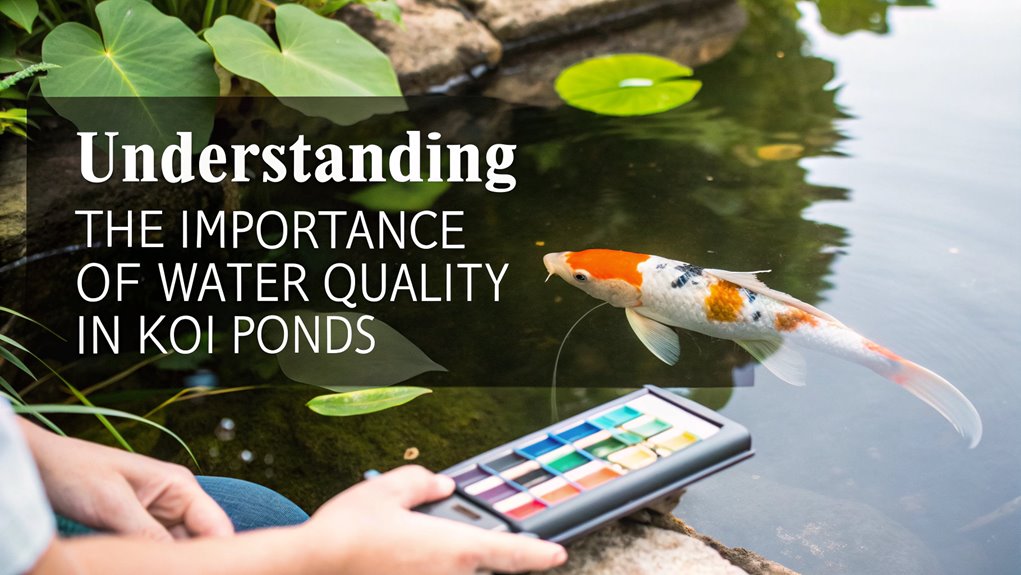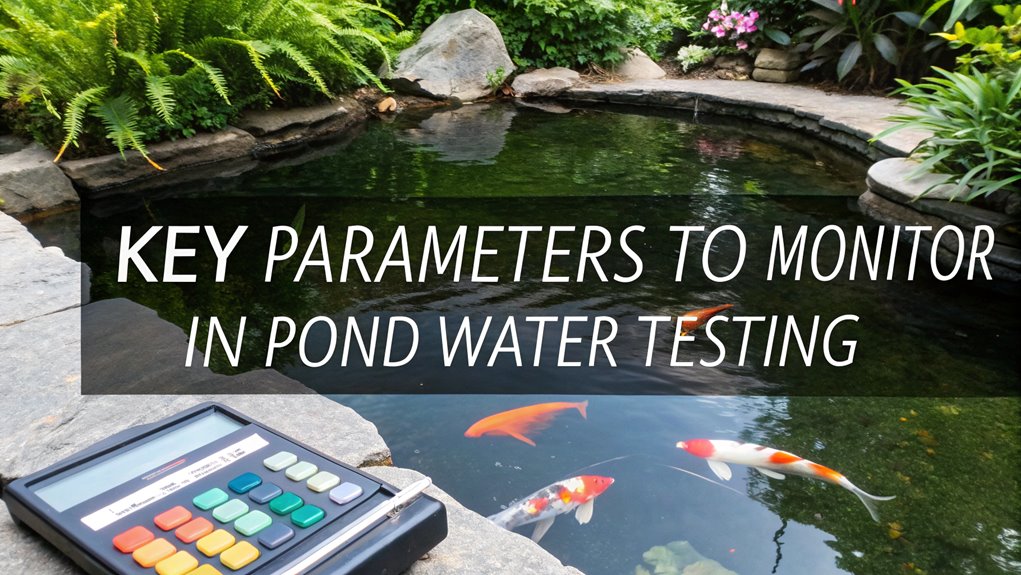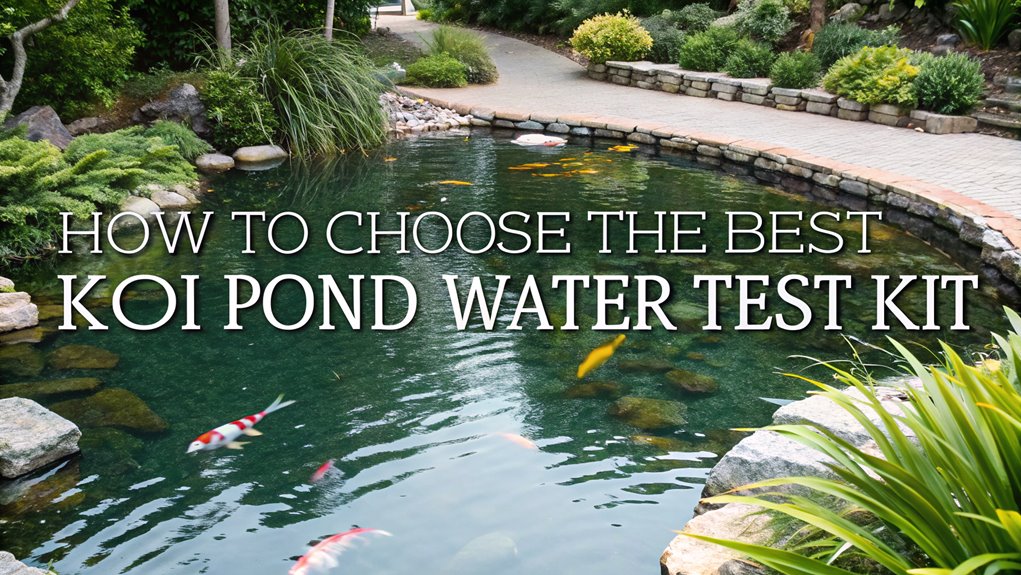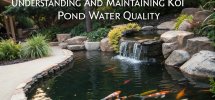To choose the best koi pond water test kit, prioritize precision in measuring critical levels like ammonia and pH, maintaining ammonia at zero and pH between 7.0-8.5 to protect your koi from stress and disease. Liquid kits, like API Pond Master, offer more accurate readings than test strips. Evaluate cost-effectiveness and ease of use to ensure consistent testing. By exploring further, you’ll discover the balance needed between accuracy, convenience, and freshwater compatibility for optimal pond health.
Key Facts Summarized
- Ensure the test kit accurately measures pH, ammonia, nitrite, nitrate, and carbonate hardness for comprehensive water quality analysis.
- Opt for liquid test kits for precise readings and reliability, especially for long-term pond management.
- Consider the number of tests provided; liquid kits typically offer more tests, enhancing value for money.
- Evaluate user-friendliness; clear instructions and color charts aid in accurate and straightforward testing.
- Balance cost against accuracy and convenience; liquid kits are generally more precise, while strips offer quick assessments.
Understanding the Importance of Water Quality in Koi Ponds

Maintaining water quality in koi ponds is essential to prevent stress and disease, which can significantly impact the health and survival of your fish.
To ensure a balanced ecosystem, you must regularly test parameters such as pH and ammonia levels. High ammonia levels, even as low as 0.3 mg/L, are toxic to koi, necessitating constant monitoring to maintain them at zero.
An optimal pH range of 7.0 to 8.5 minimizes stress and health issues. Inaccurate water test results can mislead your management efforts, endangering fish and disrupting the pond’s equilibrium.
Thus, precise water quality testing is crucial. By understanding these factors, you can create a stable environment that supports the well-being of your koi. Additionally, maintaining adequate oxygen levels in the pond is vital for the health of larger koi.
Evaluating Different Types of Test Kits for Koi Ponds

When evaluating different types of test kits for koi ponds, it’s crucial to consider the accuracy and ease of use each option provides. Liquid ammonia test kits, like the API Pond Master Test Kit, are highly accurate for testing pH, ammonia, nitrite, and nitrate levels, essential for fish health. Test strips, such as Aqua Care Pro Freshwater 6-In-1, offer convenience but may lack precision.
| Test Kit Type | Key Features |
|---|---|
| Liquid Kits | High accuracy, over 500 tests |
| Test Strips | Ease of use, less precise |
| Compatibility | Freshwater specific |
| Cost | Varies, long-term value |
Test your pond water regularly to ensure optimal conditions. Choose kits designed for freshwater environments to maintain accuracy, balancing cost and functionality for the best long-term value.
Key Parameters to Monitor in Pond Water Testing

To ensure a thriving koi pond, you must regularly monitor key water parameters that directly impact fish health and the pond ecosystem.
pH levels are paramount, as koi can adapt to a range between 7.0 and 8.5, yet stability within this range is essential.
Test for ammonia, maintaining levels at zero, since even minimal concentrations are toxic. Additionally, nitrite should also remain at zero, with a maximum of 0.2 mg/L to prevent harm.
While nitrate is less toxic, elevated levels degrade water quality and stress koi.
Carbonate hardness (kH) is crucial for pH stability, with recommended values around 6DH.
These tests ensure a balanced environment, promoting the well-being of your koi and the overall health of your pond ecosystem.
Comparing the Accuracy of Liquid vs. Strip Test Kits
Selecting the right test kit for your koi pond is crucial for maintaining optimal water quality. Liquid test kits, such as the API Pond Master Test Kit, are known for their precision, especially in measuring critical parameters like ammonia levels.
Despite being more time-consuming, they offer reliable results due to chemical reactions that minimize environmental influence. Conversely, strip test kits offer convenience but often compromise accuracy, particularly in low concentrations of ammonia and nitrite.
- Accuracy: Liquid test kits provide more precise readings due to their chemical analysis.
- Convenience: Strip test kits allow quick assessments but may lead to errors in detailed monitoring.
- Environmental Influence: Liquid tests are less impacted by lighting and color perception, ensuring consistency.
Experienced pond owners usually favor liquid kits for their dependability.
Assessing Cost and Value of Various Test Kits
While evaluating the cost and value of various test kits for your koi pond, it’s essential to consider both price and functionality.
The API Pond Master Test Kit, at $34.98, offers a cost-effective solution with over 500 tests, ensuring reliable test results for critical parameters.
In contrast, Aqua Care Pro Test Strips, priced at $12.59, provide convenient but less precise readings, illustrating a trade-off between cost and accuracy.
The Lifegard Aquatics 6-Way Test Strip Kit, although comprehensive, may not justify its $39.99 cost for budget-conscious users.
For extensive analysis, the Varify 17 In 1 Kit offers 17 parameters at $27.95+, yet sacrifices some accuracy.
API Pond 5-In-1 Strips offer ease but limited test results at $14.23+, affecting long-term value.
Considering Ease of Use and User-Friendliness
How does ease of use impact your experience with koi pond water test kits? A user-friendly kit simplifies the testing process, ensuring you accurately test water without hassle.
Liquid test kits, like the API Pond Master Test Kit, offer superior accuracy, making them ideal if precision is your priority. On the other hand, test strips such as Aqua Care Pro Freshwater 6-In-1 provide a quick, dip-and-read format, perfect for instant results.
- Clear Instructions and Color Charts: These features empower even beginners to understand results effortlessly.
- Convenient Quantity: Kits offering numerous tests, like API’s, reduce the need for frequent replacements.
- Enhanced Material Quality: Options like Lifegard Aquatics’ easy-to-read strips and desiccant packs ensure accurate, dry testing components.
Choosing user-friendly kits boosts efficiency and reliability.
Ensuring Compatibility With Freshwater Koi Ponds
When managing a koi pond, ensuring your water test kit is compatible with freshwater environments is crucial for maintaining healthy water conditions.
Most koi ponds are freshwater ecosystems, so selecting test kits designed specifically for this purpose is essential. Verify the kit’s specifications to confirm it accurately measures critical parameters such as pH, ammonia, nitrite, and nitrate levels.
Test kits like the API Pond Master Test Kit are tailored for koi ponds, providing reliable results for these parameters. Avoid test kits meant for saltwater; they can yield inaccurate readings in a freshwater setting, leading to poor decisions.
Always check compatibility labels on packaging or product descriptions to ensure the test kit meets your koi pond’s specific needs. Additionally, regular water quality checks are important to maintain optimal conditions for your koi.
Making an Informed Decision for Optimal Pond Health
Anyone managing a koi pond knows the importance of making informed decisions for maintaining optimal water quality. Selecting the right water test kit is crucial. Opt for liquid test kits over strips for more accurate readings, especially when monitoring ammonia levels, pH, nitrite, and nitrate.
Here’s how you can make better choices:
- Test Volume: Choose kits like the API Pond Master Test Kit, offering over 500 tests, ensuring cost-effective, regular monitoring.
- Compatibility: Verify the kit’s suitability for freshwater environments to avoid inaccurate assessments.
- Ease of Use: Select kits with clear instructions to simplify the testing process and promote consistent use.
Regular testing and precise results prevent koi stress, supporting a balanced and thriving ecosystem. Additionally, understanding pond maintenance practices is essential for ensuring the health of your koi. Make every test count.
Frequently Asked Questions
What Is the Most Accurate Water Test Kit?
You should choose the API Pond Master Test Kit for the most accurate results. It uses liquid reagents for precise measurements of pH, ammonia, nitrite, and nitrate, outperforming test strips, especially in koi pond environments with freshwater compatibility.
How Do I Test the Quality of My Pond Water?
Imagine your pond as a delicate ecosystem. You test its water quality by monitoring pH, ammonia, nitrite, and nitrate levels using a reliable kit. Follow instructions precisely and test weekly to protect your koi’s habitat.
What Should I Look for in a Water Test Kit?
You should prioritize liquid test kits for accuracy and ensure they measure pH, ammonia, nitrite, and nitrate levels. Check the test count for longevity, assess ease of use, and confirm compatibility with freshwater environments for precision.
Are DIY Water Testing Kits Accurate?
You might find DIY water testing kits less accurate due to environmental influences and insufficient sensitivity for detecting toxins like ammonia. Liquid kits, offering precise results through chemical reactions, are better for ensuring your koi pond’s health.
Conclusion
When selecting the ideal koi pond water test kit, it’s crucial to consider several factors. Prioritize accuracy by comparing liquid and strip options, and weigh the cost against the long-term value for your aquatic haven. Consider ease of use to ensure regular monitoring doesn’t become a chore. Compatibility with freshwater environments is essential for accurate readings. By carefully evaluating these aspects, you’ll make a well-informed decision that helps maintain your pond’s picturesque charm and your koi’s well-being.


